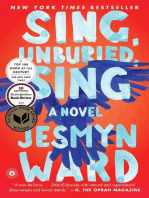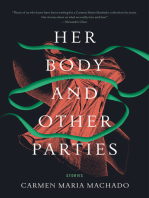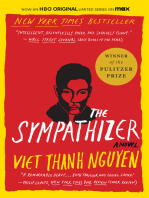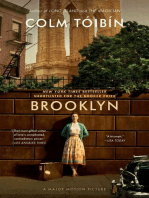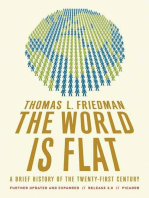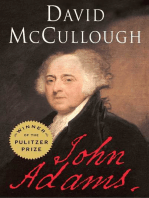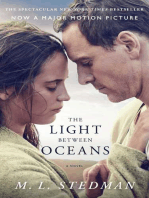0 ratings0% found this document useful (0 votes)
16 viewsAA1
AA1
Uploaded by
Angela BrioboArt can be expressed in many forms and mediums. The visual arts include mediums like painting, sculpture, photography, and design which create static or physical works. The performing arts are time-based art forms like music, dance and theater which are performed for audiences. Literary arts involve written works like novels, poems and plays. Architecture combines artistic design with practical construction. Art has both aesthetic and cultural value as a form of human expression.
Copyright:
© All Rights Reserved
Available Formats
Download as PDF, TXT or read online from Scribd
AA1
AA1
Uploaded by
Angela Briobo0 ratings0% found this document useful (0 votes)
16 views38 pagesArt can be expressed in many forms and mediums. The visual arts include mediums like painting, sculpture, photography, and design which create static or physical works. The performing arts are time-based art forms like music, dance and theater which are performed for audiences. Literary arts involve written works like novels, poems and plays. Architecture combines artistic design with practical construction. Art has both aesthetic and cultural value as a form of human expression.
Original Description:
Copyright
© © All Rights Reserved
Available Formats
PDF, TXT or read online from Scribd
Share this document
Did you find this document useful?
Is this content inappropriate?
Art can be expressed in many forms and mediums. The visual arts include mediums like painting, sculpture, photography, and design which create static or physical works. The performing arts are time-based art forms like music, dance and theater which are performed for audiences. Literary arts involve written works like novels, poems and plays. Architecture combines artistic design with practical construction. Art has both aesthetic and cultural value as a form of human expression.
Copyright:
© All Rights Reserved
Available Formats
Download as PDF, TXT or read online from Scribd
Download as pdf or txt
0 ratings0% found this document useful (0 votes)
16 views38 pagesAA1
AA1
Uploaded by
Angela BrioboArt can be expressed in many forms and mediums. The visual arts include mediums like painting, sculpture, photography, and design which create static or physical works. The performing arts are time-based art forms like music, dance and theater which are performed for audiences. Literary arts involve written works like novels, poems and plays. Architecture combines artistic design with practical construction. Art has both aesthetic and cultural value as a form of human expression.
Copyright:
© All Rights Reserved
Available Formats
Download as PDF, TXT or read online from Scribd
Download as pdf or txt
You are on page 1of 38
Art appreciation centers on the ability to view
art throughout history, focusing on the
cultures and the people, and how art
developed in the specific periods. ... Art
appreciation analyzes art using the methods
and materials, allowing people to make
connections to the context of art and the
interactions of societies.
Art is an expression made visible by a form. The expression
contained in the form is an attempt to translate the unnamed and
the unknown. Intrinsic to our existence as human is our quest to
create meaning, and art allows that process to take place.
Making meaning involves understanding our surroundings and
making our experiences. Art, at its root, is an expression and the
artist is an expresser, translating in order to create meaning. Art
expresses and translates, art acknowledges and reveals, art
transfers and art intervenes. Art is an expression, an expression
of feeling, belief and character. The simplicity of that sentence is
rather deceptive and seems tidier than its implications. Feelings,
beliefs, characteristics – these are what art expresses, although
often they are not easily distilled. Our lives as humans are full of
complications and complexities, and our thought and experience
feelings, beliefs and characteristics are reflective of these
complexities
1. Art has been created by all people
at all times, in all countries and it lives
because its well-liked enjoyed.
Naturally, arts linger on particularly if
it is popular and love by the people.
§Example: the works and writings of
Dr, Jose Rizal and the movie, The Ten
Commandments
2. Art involves experience. In order
to experience something, you have
to make use of your five senses.
Hence, there can never be
appreciation of art without having
experienced it.
3. Art is not nature; nature is not
art. Art is made by man and nature
by God. However, nature can be
enhanced by man. The enhanced
beauty and artistry of nature, then,
can be classified as an art.
4. Art is cultural. Art is a work of
humans and anything that has been
created by human is part
of culture. Art becomes cultural
when it depicts people’s way of
life, religious practices, mores and
traditions, etc.
5. Art is a form of creation. Art is
something that is created with imagination
and skill and that is beautiful or that
expresses important ideas or feelings. As
it is said, human is the creator of art. No art
can be created without human which, uses
his/her imagination and creativity to
produce art. According to the word’s most
basic definition, an artist is simply a
person who creates art.
6. Art is subjective. Henceforth, it cannot be
measured by its significance or the level of
skill with which it is created. Its subjective
nature makes arts only measurable quality is
whether or not it exists.
§Example: “beauty is in the eye of the
beholder” meaning, every individual has
his/her own perception and/or interpretation
about the subject. It would never be the same
for every individual.
The visual arts are art forms that
create works that are primarily
visual in nature, such as ceramics,
drawing, painting, sculpture,
printmaking, design, crafts,
photography, video, film making and
architecture.
The performing arts are arts such as music, dance,
and drama which are performed for an audience. It
is different from visual arts, which is when artists
use paint, canvas or various materials to create
physical or static art objects.
a time-based art form that typically features a live
presentation to an audience or to onlookers (as on
a street) and draws on such arts as acting, poetry,
music, dance, and painting.
a type of poetry that is performed for an
audience. The poetry can be written in
advance, or it can be spontaneously
composed while the performance is in
progress. It is different than just reading
poetry aloud that has been written for the
printed page.
the art and technique of designing and
building, as distinguished from the skills
associated with construction. The
practice of architecture is employed to
fulfill both practical and expressive
requirements, and thus it serves both
utilitarian and aesthetic ends.
a performing art form consisting of
sequences of movement, either
improvised or purposefully selected. This
movement has aesthetic and often
symbolic value. Dance can be categorized
and described by its choreography, by its
repertoire of movements, or by its
historical period or place of origin.
An art film is typically an independent film,
aimed at a niche market rather than a mass
market audience. A movie made primarily for
aesthetic reasons rather than commercial
profit, often of an experimental nature or
having an unconventional or highly symbolic
content, aimed typically at a limited audience.
Literary art comes from two words namely art and literature.
Art means the expression of human feelings that have
beauty value. While literature is an absorption word that
comes from Discuss Sanskrit which means guide, guidance
or order in the form of text or voice. So it can be concluded
that, literary art is actually a writing or story that comes from
the expression of human feelings that have beauty values.
Literary or literary art is something in the form of writing or
stories that have artistic and cultural value that displays the
beauty of speech and language to convey certain meanings.
art of writing literary works such as poems, novels, plays,
memoirs, or biographies.
Theatre is a collaborative art form
which combines words, voice, movement
and visual elements to express meaning. ...
Theatre is about the examination and
resolution of fundamental human issues, and is
built on understanding and presenting
interactions between people.
The applied arts are all the arts that
apply design and decoration to
everyday and essentially practical
objects in order to make them
aesthetically pleasing. ... Applied arts
largely overlaps with decorative arts, and
the modern making of applied art is
usually called design.
• Visual Arts • Film
• Performance Art • Literary
• Poetry - • Theater
performance • Applied Arts
• Architecture (Fashion, Furniture)
• Dance
You might also like
- The Subtle Art of Not Giving a F*ck: A Counterintuitive Approach to Living a Good LifeFrom EverandThe Subtle Art of Not Giving a F*ck: A Counterintuitive Approach to Living a Good LifeRating: 4 out of 5 stars4/5 (5891)
- The Gifts of Imperfection: Let Go of Who You Think You're Supposed to Be and Embrace Who You AreFrom EverandThe Gifts of Imperfection: Let Go of Who You Think You're Supposed to Be and Embrace Who You AreRating: 4 out of 5 stars4/5 (1103)
- Never Split the Difference: Negotiating As If Your Life Depended On ItFrom EverandNever Split the Difference: Negotiating As If Your Life Depended On ItRating: 4.5 out of 5 stars4.5/5 (870)
- Grit: The Power of Passion and PerseveranceFrom EverandGrit: The Power of Passion and PerseveranceRating: 4 out of 5 stars4/5 (597)
- Hidden Figures: The American Dream and the Untold Story of the Black Women Mathematicians Who Helped Win the Space RaceFrom EverandHidden Figures: The American Dream and the Untold Story of the Black Women Mathematicians Who Helped Win the Space RaceRating: 4 out of 5 stars4/5 (912)
- Shoe Dog: A Memoir by the Creator of NikeFrom EverandShoe Dog: A Memoir by the Creator of NikeRating: 4.5 out of 5 stars4.5/5 (543)
- The Hard Thing About Hard Things: Building a Business When There Are No Easy AnswersFrom EverandThe Hard Thing About Hard Things: Building a Business When There Are No Easy AnswersRating: 4.5 out of 5 stars4.5/5 (352)
- Elon Musk: Tesla, SpaceX, and the Quest for a Fantastic FutureFrom EverandElon Musk: Tesla, SpaceX, and the Quest for a Fantastic FutureRating: 4.5 out of 5 stars4.5/5 (474)
- Her Body and Other Parties: StoriesFrom EverandHer Body and Other Parties: StoriesRating: 4 out of 5 stars4/5 (830)
- The Sympathizer: A Novel (Pulitzer Prize for Fiction)From EverandThe Sympathizer: A Novel (Pulitzer Prize for Fiction)Rating: 4.5 out of 5 stars4.5/5 (122)
- The Little Book of Hygge: Danish Secrets to Happy LivingFrom EverandThe Little Book of Hygge: Danish Secrets to Happy LivingRating: 3.5 out of 5 stars3.5/5 (414)
- The Emperor of All Maladies: A Biography of CancerFrom EverandThe Emperor of All Maladies: A Biography of CancerRating: 4.5 out of 5 stars4.5/5 (272)
- The Yellow House: A Memoir (2019 National Book Award Winner)From EverandThe Yellow House: A Memoir (2019 National Book Award Winner)Rating: 4 out of 5 stars4/5 (99)
- The World Is Flat 3.0: A Brief History of the Twenty-first CenturyFrom EverandThe World Is Flat 3.0: A Brief History of the Twenty-first CenturyRating: 3.5 out of 5 stars3.5/5 (2270)
- Devil in the Grove: Thurgood Marshall, the Groveland Boys, and the Dawn of a New AmericaFrom EverandDevil in the Grove: Thurgood Marshall, the Groveland Boys, and the Dawn of a New AmericaRating: 4.5 out of 5 stars4.5/5 (269)
- Team of Rivals: The Political Genius of Abraham LincolnFrom EverandTeam of Rivals: The Political Genius of Abraham LincolnRating: 4.5 out of 5 stars4.5/5 (235)
- A Heartbreaking Work Of Staggering Genius: A Memoir Based on a True StoryFrom EverandA Heartbreaking Work Of Staggering Genius: A Memoir Based on a True StoryRating: 3.5 out of 5 stars3.5/5 (232)
- On Fire: The (Burning) Case for a Green New DealFrom EverandOn Fire: The (Burning) Case for a Green New DealRating: 4 out of 5 stars4/5 (74)
- The Unwinding: An Inner History of the New AmericaFrom EverandThe Unwinding: An Inner History of the New AmericaRating: 4 out of 5 stars4/5 (45)
- Cpar NWST QeDocument10 pagesCpar NWST QeJer Mark BeldadNo ratings yet
- BOW in MAPEHDocument47 pagesBOW in MAPEHJhen MendozaNo ratings yet
- WAGNER, Richard. On Poetry and Composition PDFDocument15 pagesWAGNER, Richard. On Poetry and Composition PDFclownmunidadeNo ratings yet
- Visual CultureDocument10 pagesVisual CultureJohn Mark JubelagNo ratings yet
- 2013 Wassce Gka - Paper 2 SolutionDocument4 pages2013 Wassce Gka - Paper 2 SolutionKwabena AgyepongNo ratings yet
- Andy Warhol Ai Weiwei NGV 2015Document165 pagesAndy Warhol Ai Weiwei NGV 2015Cris BolañosNo ratings yet
- Creative Arts Basic 8Document13 pagesCreative Arts Basic 8danielitodebravo37No ratings yet
- 06 - Chapter 1 PDFDocument28 pages06 - Chapter 1 PDFNishant Shekhar JhaNo ratings yet
- NPI Price List - CAT DEKORATIF (Jul 2023) PAL, BKL, LMP +PLP - Revisi Washi Tape & Sandpaper - Din030723Document12 pagesNPI Price List - CAT DEKORATIF (Jul 2023) PAL, BKL, LMP +PLP - Revisi Washi Tape & Sandpaper - Din030723oped baeNo ratings yet
- (Islam in The World) Sophia Vasalou - Al-Ghazali and The Idea of Moral Beauty-Routledge (2021)Document89 pages(Islam in The World) Sophia Vasalou - Al-Ghazali and The Idea of Moral Beauty-Routledge (2021)Ricardo Japonos RibeiroNo ratings yet
- Carlos Xuma - Dating Dynamics - Getting Men More Success With Women (2005)Document46 pagesCarlos Xuma - Dating Dynamics - Getting Men More Success With Women (2005)janejankovicNo ratings yet
- Philip J. Davis - Mathematics & Common Sense - A Case of Creative Tension-A K Peters (2006) PDFDocument289 pagesPhilip J. Davis - Mathematics & Common Sense - A Case of Creative Tension-A K Peters (2006) PDFMiguel Angel Hanco Choque100% (1)
- Inside The White CubeDocument12 pagesInside The White Cubeapi-223835704No ratings yet
- Neo Classicism To ExpressionismDocument6 pagesNeo Classicism To ExpressionismJuju OdabitNo ratings yet
- ARTSDocument9 pagesARTSDiana FaustinoNo ratings yet
- In The Hear of The WoodDocument5 pagesIn The Hear of The WoodNoriko NakamuraNo ratings yet
- Various Art Forms in The PhilippinesDocument85 pagesVarious Art Forms in The PhilippinesLyka Marie PesaNo ratings yet
- Alice in Wonderland Study Guide ProofDocument18 pagesAlice in Wonderland Study Guide ProofChildren's Theatre Company100% (1)
- German Aesthetics - Fundamental Concepts From Baumgarten To - J. D. Mininger Jason Michael Peck (Editors) - New Directions in German Studies, 2016 - 9781501321511 - Anna's ArchiveDocument282 pagesGerman Aesthetics - Fundamental Concepts From Baumgarten To - J. D. Mininger Jason Michael Peck (Editors) - New Directions in German Studies, 2016 - 9781501321511 - Anna's Archives hNo ratings yet
- Cpar Study GuideDocument10 pagesCpar Study GuideChelsey RotorNo ratings yet
- Art AppeciationDocument22 pagesArt AppeciationKF RadaNo ratings yet
- Module 1 Nature of LiteratureDocument6 pagesModule 1 Nature of LiteratureRoldan MapeNo ratings yet
- Masters of Science Fiction and Fantasy Art - A Collection of The Most Inspiring Science Fiction, Fantasy, and Gaming Illustrators in The World-Rockport Publishers (2011)Document225 pagesMasters of Science Fiction and Fantasy Art - A Collection of The Most Inspiring Science Fiction, Fantasy, and Gaming Illustrators in The World-Rockport Publishers (2011)filipef100% (3)
- Joke Brouwer Arjen Mulder Lars Spuybroek: Ital BeautyDocument4 pagesJoke Brouwer Arjen Mulder Lars Spuybroek: Ital BeautyfwhiteheadNo ratings yet
- Paragraph Summarizing Test 3Document7 pagesParagraph Summarizing Test 3Allan Abad0% (1)
- Use of English and Reading VersionDocument10 pagesUse of English and Reading VersionLucía Di CarloNo ratings yet
- Classification EssayDocument4 pagesClassification Essayapi-511995030No ratings yet
- La Universidad Central Durante La Segunda República. Las Ciencias Humanas y Sociales y La Vida UniversitariaDocument388 pagesLa Universidad Central Durante La Segunda República. Las Ciencias Humanas y Sociales y La Vida UniversitariaJosé Carlos RivasNo ratings yet
- 2.1 Linear-Perspective-Text-Lecture PDFDocument11 pages2.1 Linear-Perspective-Text-Lecture PDFKrishnaPriyaNo ratings yet
- Art App ReviewerDocument5 pagesArt App ReviewerASIANSison, Shekainah May SisonNo ratings yet





